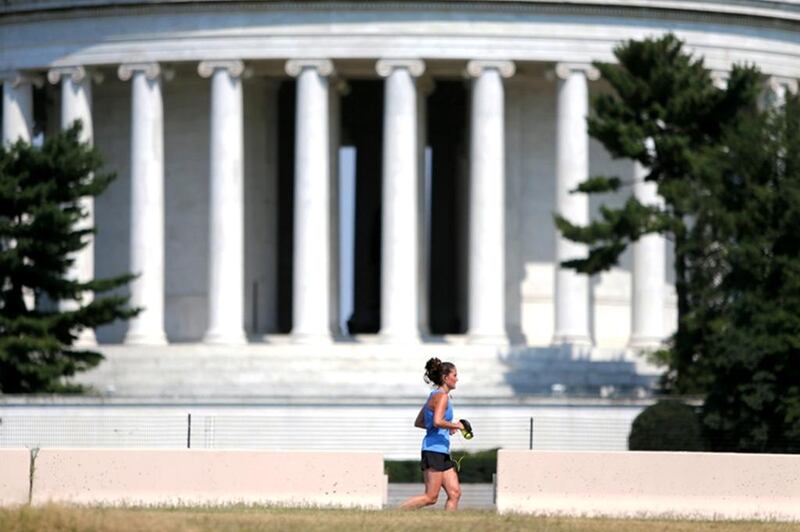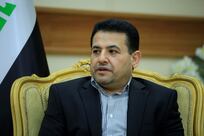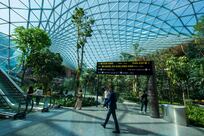We’re sat on the edge of the Potomac river in Washington, six strangers, toes dangling in the water as we ready ourselves to jump.
Ahead of us, hundreds of others have already leapt, their bodies now struggling against its murky waters, arms thrashing and necks straining, gasping for breath.
It is barely dawn, yet behind us an army of masochists winds round the river, waiting their turn. They are thousands-strong, grown men and women, all of them visibly agitated, filled with horror at the self-harm that looms ahead.
We are about to make good on a pact that for some was made months, even years, before. Today is the day we sacrifice ourselves to the vengeful currents below. The day we jump into the Potomac.
Or at least, that’s how it seems. But as the sun comes up, its rays bouncing off our neon Lycra mankinis and shiny rubber wetsuits, an entirely different picture emerges. It is one dominated by men with shaved legs and tubs of Vaseline, a world where women wear stern expressions and flex fearsome physiques. A world where the fearsome stench is from the oversubscribed pre-race portable toilets. This is the territory of the Mamil (Middle-Aged Man in Lycra). This is a triathlon.
Not just any triathlon, but one of North America’s largest: officially called the Nation’s Triathlon. Ahead of the estimated 5,000 participants – drawn from 14 countries – lies a 1.5 kilometre dip in the Potomac, a 40km cycle past many of the town’s most celebrated monuments and a 10km run along the Washington channel.
Quite why the participants have signed up is unclear. Those stubborn enough to complete the course will have little to show for the effort, beyond a bottle of Gatorade, a finisher’s medal and, for those who forgot the Vaseline, wince-inducing chafing.
Supposedly, this is a competition, yet few here are competing. Hundreds are raising money for the Leukemia and Lymphoma Society, others because they accepted an ill-advised wager and some are picking up a gauntlet thrown down by a former, flabbier version of themselves.
The most awe-inspiring examples are the armed forces veterans taking part, some with up to three limbs missing, who shame the rest not only with their indomitable spirit, but also their athletic prowess.
Yet the question remains: why? Why must the personal challenge involve donning a brightly coloured leotard and jumping into a murky river?
If the motivations of the competitors are unclear, those of the sponsors Etihad are positively obscure.
Why has it asked a group of 7ft-tall air hostesses to wander around the streets of Washington handing out fairy cakes emblazoned with motivational slogans? And why are the same giant ladies stooping down to award medals to athletes as they cross the finish line? The glamour they provide – it is the same team who attend to drivers at the Abu Dhabi Grand Prix – seems incongruous with the world of amateur triathlon, perhaps the world’s least sexy sport.
Perhaps Omar Nour, the Nation’s Tri mascot, holds some of the answers. Five years ago, Nour picked up the gauntlet thrown down by his flabby, 105 kilogram self and dropped to 87kgs in four months of training. Now 34, and thin as a whippet, Nour is a professional with his sights set on the Rio Olympics.
Yet Nour is more than merely a mascot. He is the human link binding the Washington Tri to another race 11,000 kilometres away in Abu Dhabi – TriYas, its newly official twin event, held this Friday. His is the spandex that stretches the Atlantic to bind two world capitals together.
An Egyptian who lives in DC, Nour is well known in Abu Dhabi. He trains in the emirate in the winter, takes part in TriYas and gives motivational talks to the emirate’s schoolchildren. At 6ft 4in, he is a sportsman, personality and Arab role model all rolled into one.
For race weekend, he bounces around the city, inspiring participants with his infectious enthusiasm, hosts boat tours on the Potomac and dutifully attends the Georgetown Cupcake shop on 33rd and M Streets, where shoppers queue down the road for fairy cakes served by the Etihad crew. Stephen LaMontagne, the owner, is expecting to sell 20,000 cakes this weekend. Nour poses with a cake, but is unwilling to take a bite, perhaps mindful of his former self.
He hopes his involvement can interest athletes in visiting Abu Dhabi. He and Yas Marina Circuit are planning to hold a triathlon tuition camp to highlight the capital’s credentials as a winter training destination for both professionals and amateurs. “Just like London has Hyde Park and New York has Central Park, Abu Dhabi has Yas Island,” he says. “Where else in the world do they open a Grand Prix racetrack for the public to run and bike around?”
There are other Abu Dhabi faces, too. A delegation from Yas Marina has been wandering around Washington for days wearing luminous pink TriYas T-shirts. They get a lot of strange looks, yet with such high visibility they are unlikely to be trod upon by wandering female giants from the Middle East.
Leading the Yas men is Nick McElwee, who has shaved his legs on Nour’s advice. (“If he’s not shaved, he’s not serious” is how Nour sizes up his opponents).
But McElwee is deadly serious. Batting away suggestions that Day-Glo pink is not an entirely macho look, and with the sun reflecting off his newly smooth, aerodynamic shins, the marketing guru explains that twinning the two triathlons is a way of speaking to people on a “segmented group level”.
“The long-term plan is to position Abu Dhabi as a sports tourism destination and we want to be at the heart of that,” he says. “We want to attract professional and amateur athletes and this is the start. Rather than just saying: ‘Abu Dhabi is open for business’, you’ve got to give people reasons to travel.”
But people already have plenty of reasons to travel between the two capitals – Etihad introduced direct flights in March last year and the route enjoys 80 per cent occupancy. It’s hard to imagine that encouraging triathletes to travel for two races each year will significantly affect the company’s bottom line.
And if the company’s not here for the money, then why is it?
The answer comes at the end of a sparkling VIP event held at the UAE’s Washington embassy, where athletes rub shoulders with diplomats and pink T-shirts jar against the starched collars and tuxedos.
As the guests depart, the Etihad ladies hand out goody bags. The bags contain fairy cakes, possibly aimed at carbo-loading athletes, and the fabled luminous pink TriYas T-shirt. “Be one of us” appears to be the message.
But there is more. Also included is a report from the US-UAE Business Council and it is in this unlikeliest of all locations that the answer to that seemingly ineffable question “Why?” is to be found.
For, hidden away at the end of its nine pages of dense business analysis of the two country’s commercial links, there is a conclusion so sweet, so insightful to the nature of amateur sport – nay human existence itself – that it bears repeating:
“We would be remiss in closing if we did not lift up a wonderful intangible of all this activity,” reads the report’s conclusion. “The positives that flow from human interaction, from travelling to new places and getting to know each other … when we do that, the world becomes, little by little, a safer, more peaceful and more tolerant place.”
In other words, triathletes are like Day-Glo diplomats, a front line forging friendship between nations, our strange and questionable fashion choices disarming even the most hostile stares. In the animal kingdom, bright colours mean: “Danger, I’m poisonous.” In the Mamil kingdom they mean: “Relax, I’m not even serious.” In the face of such vulnerability, such fashion faux pas, fear and suspicion are impossible.
Stripped down to our mankinis, it is plain for all to see: underneath we are the same, so let’s be friends, you and me. Our neon leotards distance us from many, but they bind the few ever tighter. This is why we can face our fears, in those dark hours before sunrise, when we are certain we are alone and doomed. We need only to wait for those first rays to reflect our luminescence. We are an army of lighthouses, thousands strong. We are Mamil. Hear us roar.
• TriYas is held on Friday at the Yas Marina Circuit, Abu Dhabi. Visit www.yasmarinacircuit.com and www.facebook.com/triyasuae for details
[ artslife@thenational.ae ]






